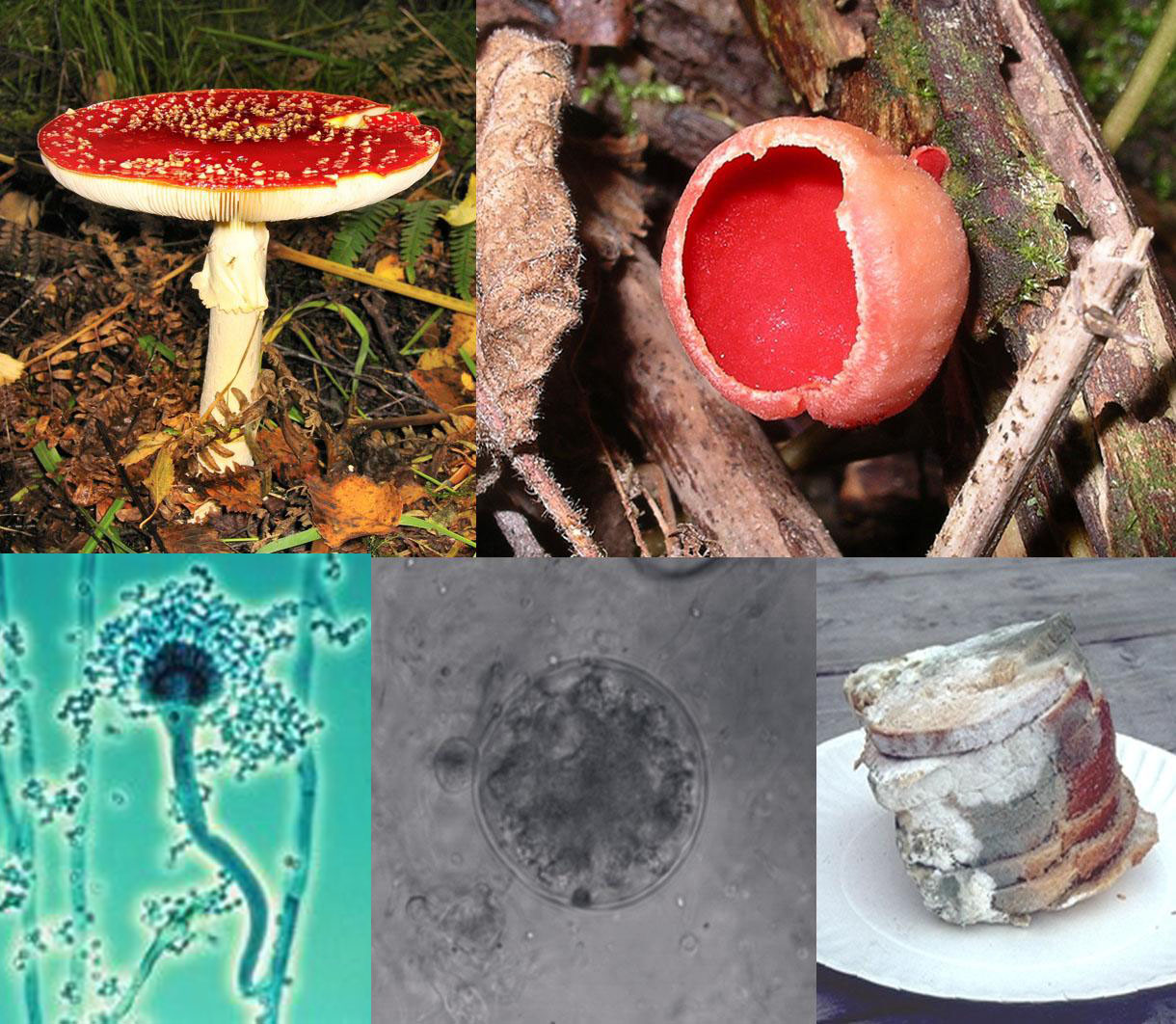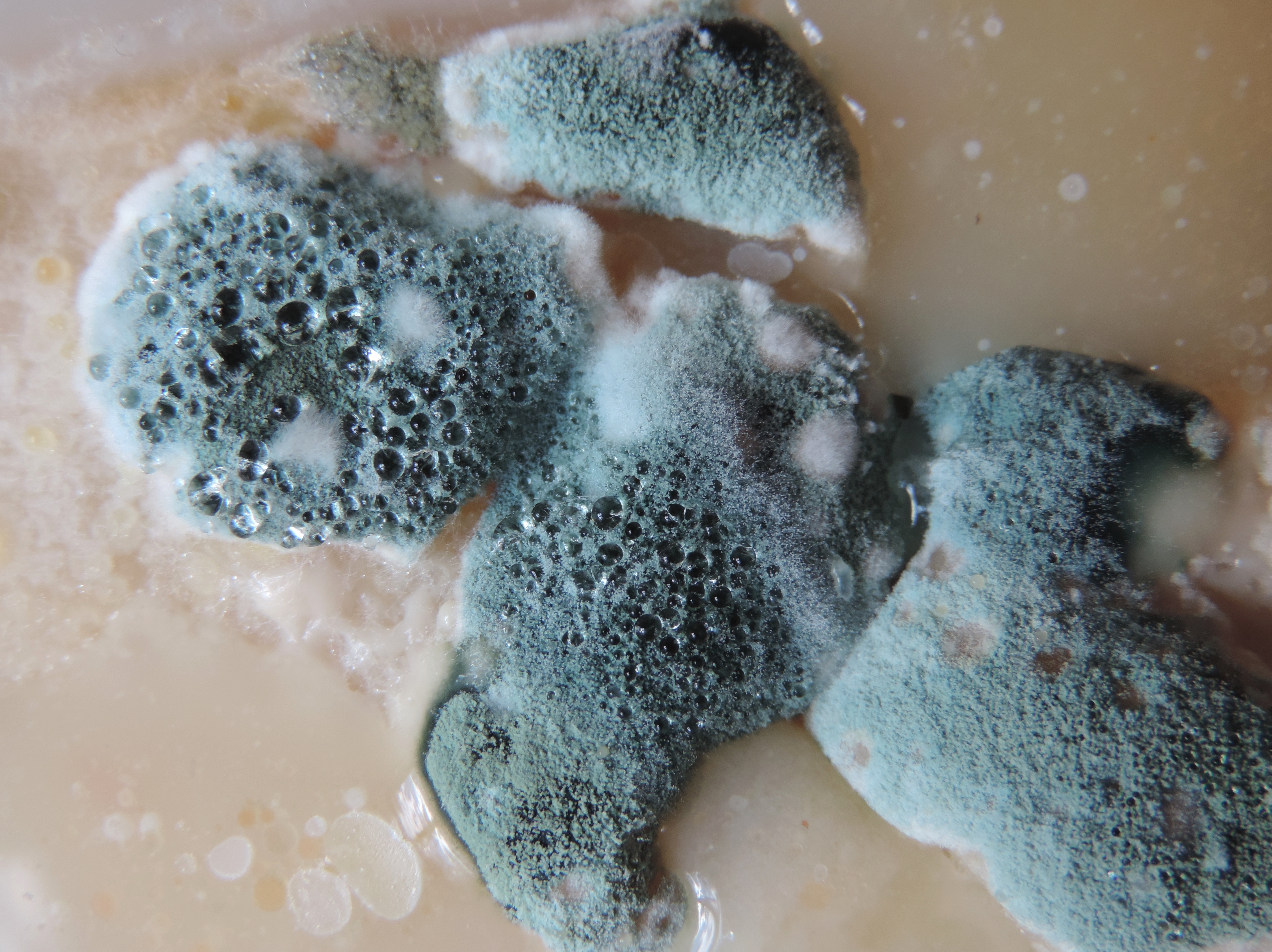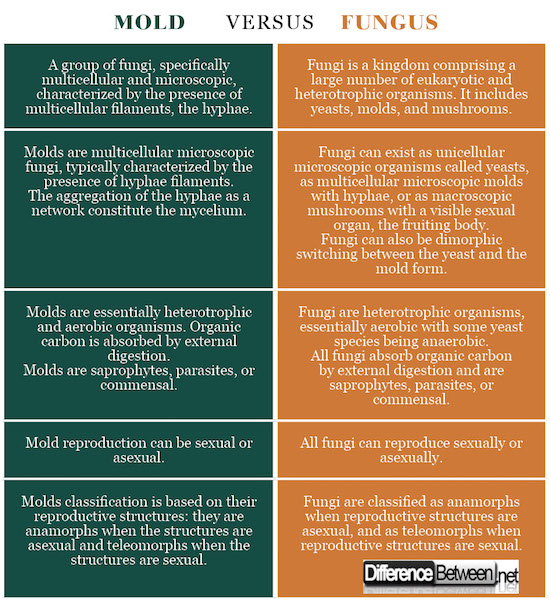Difference between Mold and Fungus
What is Fungus?
The kingdom Fungi, the plural of fungus, are eukaryotic and heterotrophic organisms, capable of absorbing organic carbon. They are essentially aerobic and include yeasts, molds, and mushrooms.
Yeasts are unicellular microscopic organisms which reproduce vegetatively by budding. Molds are microscopic as well and are characterized by the presence of multicellular hyphae forming a mycelium. Mushrooms, on the other side, present a macroscopic sexual organ, the fruiting body where the sexual spores are produced.
A number of fungi species are dimorphic and are capable of growing as yeasts or molds according to the temperature or CO2 concentration. An example is Blastomyces dermatitidis which can exist as both mold and yeast.
Fungi absorb their nutrients through their cell wall following the release of specific enzymes which digest organic macromolecules in the extracellular environment.
The digested molecules then cross by diffusion through the fungal cellular envelope. Fungi are saprophytes when the carbon originates from nonliving substrates and parasites or commensal when the source of carbon is a living organism.
Reproduction in fungi occurs by the production of spores which can be sexual or asexual. Sexual reproduction involves the fusion of two haploid nuclei. This is followed by a meiotic division of the nucleus.
During asexual reproduction, asexual spores called sporangiospores are formed and divide subsequently by mitosis.
Fungi are classified based on their reproductive system: sexual, asexual, or as in some cases a combination of both. Anamorphs constitute asexual reproductive structures, and teleomorphs constitute the sexual reproductive structures. The term holomorph is used to refer to the complete fungus with its anamorph and its teleomorph structures.

What is Mold
Molds are a microscopic type of fungi, which unlike the unicellular microscopic yeasts or the macroscopic multicellular mushrooms, are characterized by the presence of multicellular filaments called hyphae. The network formed by the hyphae constitute the mycelium which is visible to the naked eye.
Hyphae grow by apical elongation, a process involving the fusion of vesicles with the plasma membrane at the apex, the consecutive digestion of the membrane, and the formation of a new cell wall.
Molds can reproduce sexually by forming zygospores which result from the fusion of two haploid cells. When the environmental conditions are favorable, a zygospore undergoes meiosis, the cellular division which results in two new haploid cells different than the parent cell.
Molds can also reproduce asexually. In this case, sporangiospores are released from special hyphae called sporangiophores. Sporangiospores are diploid cells that undergo mitosis producing new cells that are identical to the parent cell.

Difference between Mold and Fungus
-
Definition of Mold and Fungus
Fungi is a kingdom comprising a large number of species which are eukaryotic and heterotrophic organisms. It includes yeasts, molds, and mushrooms.
Molds are a group of fungi, which are specifically multicellular microscopic organisms characterized by the presence of multicellular filaments, the hyphae.
-
Morphology of Mold and Fungus
Fungi can exist as unicellular microscopic organisms called yeasts, as multicellular microscopic molds with hyphae, or as macroscopic mushrooms with a visible sexual organ, the fruiting body.
Some specific fungi can also be dimorphic, present as both molds and yeasts, switching between the two forms according to the environmental conditions such as temperature or CO2 concentration.
Molds, on the other hand, are multicellular microscopic fungi, typically characterized by the presence of hyphae filaments. The aggregation of the hyphae as a network constitute the mycelium, visible to the eye.
-
Physiology of Mold and Fungus
All fungi including molds are essentially heterotrophic and aerobic organisms, with only some yeast species being anaerobic.
They are both able to absorb organic carbon from the environment through external digestion. Catalytic enzymes are secreted and released into the extracellular environment where macromolecules such as sugar, lipids, and proteins are therefore digested. The resulting small molecules are then absorbed by diffusion into the fungi cells.
Fungi and molds are called saprophytes when the carbon originates from nonliving substrates and parasites or commensal when the source of carbon is a living organism.
-
Reproduction of Mold and Fungus
Fungi such as yeasts and molds alike reproduce by the production of spores which can be sexual or asexual. Sexual reproduction involves the fusion of two haploid nuclei followed by the meiotic division of nucleus and resulting in two cells which are different from the parent cell.
Asexual reproduction occurs when diploid spores are formed and divide subsequently by mitosis, producing two diploid cells identical to the parent cell.
-
Classification of Mold and Fungus
All fungi including molds are classified based on their reproductive structures. They are called anamorphs when they reproduce asexually, teleomorphs when they present sexual reproductive structures.
The fungus and mold is a holomorph referring to both its asexual and sexual structures.
Mold versus Fungus: Comparion Chart

Summary of Mold and Fungus
Molds are a group of microorganisms belonging to the kingdom of Fungi, which comprises as well yeasts and mushrooms.
The main difference between molds and other fungal species resides in their morphology. Molds are multicellular microscopic organisms characterized by the presence of filaments called hyphae, while yeasts are unicellular microorganisms, and mushrooms present a macroscopic fruiting body producing spores.
- Differences Between Irreversible Enzyme Inhibitors and Reversible Enzyme Inhibitors - May 23, 2018
- Difference Between T cells and B cells - April 5, 2018
- Difference Between Primary Pollutants and Secondary Pollutants - March 17, 2018
Search DifferenceBetween.net :
1 Comment
Leave a Response
References :
[0]Image credit: https://commons.wikimedia.org/wiki/File:Mold_6552.jpg#/media/File:Mold_6552.jpg
[1]Image credit: https://en.wikipedia.org/wiki/Fungus#/media/File:Fungi_collage.jpg
[2]Kylie J. Boyce, Alex Andrianopoulos; Fungal dimorphism: the switch from hyphae to yeast is a specialized morphogenetic adaptation allowing colonization of a host, FEMS Microbiology Reviews, Volume 39, Issue 6, 1 November 2015, Pages 797–811, https://doi.org/10.1093/femsre/fuv035
[3]Cole GT. Basic Biology of Fungi. In: Baron S, editor. Medical Microbiology. 4th edition. Galveston (TX): University of Texas Medical Branch at Galveston; 1996. Chapter 73. Available from: https://www.ncbi.nlm.nih.gov/books/NBK8099/
[4]McGinnis MR, Tyring SK. General Concepts of Mycology. In: Baron S, editor. Medical Microbiology. 4th edition. Galveston (TX): University of Texas Medical Branch at Galveston; 1996. Available from: https://www.ncbi.nlm.nih.gov/books/NBK8165/
[5]McGinnis MR, Tyring SK. Introduction to Mycology. In: Baron S, editor. Medical Microbiology. 4th edition. Galveston (TX): University of Texas Medical Branch at Galveston; 1996. Available from: https://www.ncbi.nlm.nih.gov/books/NBK8125/

i won’t to learn more about fungus and mold